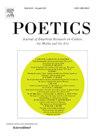Detailing social influence in predicting cinema attendance: a vignette approach
IF 1.7
2区 社会学
0 LITERATURE
引用次数: 0
Abstract
The movie market is full of incommensurable products, encouraging consumers to rely on various judgment devices of a social nature (e.g., ratings and recommendations) to make choices. However, the role of movie genres and individual characteristics in relying on judgment devices remains uncertain.
Drawing upon Karpik’s theory of the economics of singularities, this study examines social influence in a movie market by employing a factorial survey to investigate the role of movie ratings and recommendations in predicting the likelihood of going to the cinema to watch a movie across four genres: romance, sci-fi, documentary and horror — genres distinguished by their varying levels of social stratification and popularity. The vignettes are presented in the form of pictures, depicting either low, middle or high ratings by movie experts, broad audience and peers, as well as personal recommendations from close friends, parents or neither.
First, the results reveal that the ratings by experts, broad audience and peers emerge as positive predictors; the gain from each rating's increase from the middle level to the highest level is greater than the loss from a decrease from the middle level to the lowest level among all movie genres. Second, personal recommendation by close friends, rather than parents, holds the highest significance regardless of the genre. Third, orientation toward specific judgment devices depends on individual characteristics of respondents, such as trust in family and importance of friends, genre preferences and the level of cultural omnivorousness.
预测电影出勤率的详细社会影响:一个小插曲的方法
电影市场充斥着不可通约率的产品,促使消费者依靠各种社会性的判断手段(如评分、推荐)进行选择。然而,电影类型和个体特征在依赖判断手段中的作用仍然不确定。借鉴Karpik的奇点经济学理论,本研究考察了电影市场的社会影响,通过采用因子调查来调查电影评级和推荐在预测去电影院观看四种类型电影的可能性方面的作用:浪漫、科幻、纪录片和恐怖——这些类型以其不同的社会分层水平和受欢迎程度而区分开来。这些小短片以图片的形式呈现,描绘了电影专家、普通观众和同行的低、中、高评分,以及亲密朋友、父母或两者都不是的个人推荐。首先,结果表明,专家、广大受众和同行的评分是积极的预测因素;在所有电影类型中,每一部电影的评分从中级上升到最高级所带来的收益大于从中级下降到最低等级所带来的损失。其次,不管是哪种类型的电影,好友的推荐比父母的推荐更重要。第三,对特定判断手段的倾向取决于被调查者的个人特征,如对家庭的信任和对朋友的重要性、类型偏好和文化包容性水平。
本文章由计算机程序翻译,如有差异,请以英文原文为准。
求助全文
约1分钟内获得全文
求助全文
来源期刊

Poetics
Multiple-
CiteScore
4.00
自引率
16.00%
发文量
77
期刊介绍:
Poetics is an interdisciplinary journal of theoretical and empirical research on culture, the media and the arts. Particularly welcome are papers that make an original contribution to the major disciplines - sociology, psychology, media and communication studies, and economics - within which promising lines of research on culture, media and the arts have been developed.
 求助内容:
求助内容: 应助结果提醒方式:
应助结果提醒方式:


